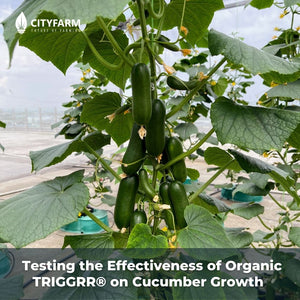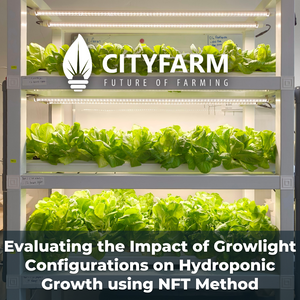[Research] Effects of DLI on the Growth of Lollo Bionda(Coral Lettuce)
![[Research] Effects of DLI on the Growth of Lollo Bionda(Coral Lettuce)](http://cityfarm.my/cdn/shop/articles/DLI_RESEARCH_ON_LOLLO_BIONDA_1024x.png?v=1577512785)
Effects of DLI on the Growth of Lollo Bionda
Daily Light Interval (DLI) is the rate of photosynthetically active radiation delivered to a square meter region (m2) in a day, expressed in the unit of mol·m-2·d-1. It is a measurement of the light environment which is vital for the light requirement in plant growth. An experiment was conducted to test the effect of DLI on the growth of Lollo Bionda in 6.5, 10, 18 and 23 mol·m-2·d-1.
Type of plant: Lollo Bionda
Light distance from plant: 25 cm
Lighting duration per day: 16 hours
Procedure:
System Setup
- Different number of grow lights were built on the four NFT channels of City Vertical Farm M (Indoor NFT System) to perform different DLI. Grow lights were installed in the amount of 1, 2, 3 and 4 on different row of NFT channels accordingly.
|
NFT Channel |
1 |
2 |
3 |
4 |
|
Number of LED grow light |
1 |
2 |
3 |
4 |
|
DLI (mol·m−2·d−1) |
6.5 |
10 |
18 |
23 |
Plants Germination and Growth
- The seeds were soaked in a film of water for two days.
- After two days, the germination seeds were transferred to the wet germination sponge for further growth development.
- After two weeks, 24 seedlings about 5 cm were transplanted to the system under different number of grow lights for an observation for 28 days.
- Initial and final weight of every plants were measured for comparison. Number of leaves per plant and their appearance were observed and recorded every week.
Observation:
DAT 7. Lollo bionda in Channel 1 was obviously having lesser leaves when compared to the other three initially. In terms of comparison between the heights, Lollo bionda in Channel 4 was shorter than the others.

DAT 14. The condition continued on Lollo Bionda in Channel 1 to have lesser amount of leaves and smaller leaves’ surface. They also had longger leaves than others. Tip burn started to occur at the new leaves of Lollo Bionda in Channel 3 and 4.
DAT 21. New leaves on Lollo Bionda in Channel 4 had the most tip burn problem, followed by Channel 3 and least tip burn problem in Channel 2. However, their leaves were rigid and compact as more leaves were grown. There was no tip burn problem in Channel 1, however the leaves were soft, loosely grown and longer than the plants in other channels.
DAT 28. In comparison for the root part, Lollo Bionda in Channel 4 had the most amount of roots and most compact among the plants in other channels. In the overall, Lollo bionda in Channel 1 has the least amount of leaves and roots, but no tip burn problem occurred. Lollo Bionda in Channel 2, 3 and 4 were all detected to have tip burn on their old and new leaves.
Result:
Average Weight per Plants
|
Channel |
1 |
2 |
3 |
4 |
|
Daily Light Interval (mol·m−2·d−1) |
6.5 |
10 |
18 |
23 |
|
Average Initial Weight per Plant, g |
1.63 |
1.18 |
1.37 |
1.30 |
|
Average Final Weight per Plant, g |
66.32 |
123.35 |
151.48 |
138.18 |

Average Number of Leaves per Plants
All of the Lollo Bionda initially started with four leaves per plant. The difference on average leaves per plant started on DAT 14 when Lollo Bionda on Channel 2 had the highest average number of leaves (9.67) while Channel 4 had the lowest number (7). At the end of the experiment, Lollo Bionda on Channel 2 and 3 had about the same average number of leaves (20 and 20.5) while Channel 1 and 4 had the same lowest average number (15.67). Lollo Bionda on Channel 4 experienced stunted growth on leaves on DAT 7 to DAT 21. However, the data shows that the average number of all plants increased up to 6-7 leaves per plants after DAT 21 including Channel 4 which increased from 8.17 to 15.67.
Discussion
Plants under DLI 10 mol·m−2·d−1 and 18 mol·m−2·d−1 produced more leaves then 6.5 mol·m−2·d−1 and 23 mol·m−2·d−1. However, DLI 18 mol·m−2·d−1 and 23 mol·m−2·d−1 will produce more weight per plant. According to Faust et al. (2005), low DLI results in reduced water stress due to low transpiration which will lead to taller plants as what happened to Lollo Bionda in Channel 1 on DAT 7 and 14. Reduction in water stress will also produce softer leaves as they have higher percentage of water above the ground tissues. Eventually, the plant growth and their quality will be affected under low DLI as shown in the average number of leaves and weight gained on the Lollo Bionda in Channel 1.
As the DLI increased, plant tissues will produce higher proportion of structural materials and carbohydrates. Hence, the leaves under high DLI are more compact and rigid, which might also produce good texture in the salad dishes. However, high DLI will bring bad effect on the plant growth as shown in Lollo Bionda in Channel 4. When the DLI is high, plant will undergo rapid growth due to the increase in light energy. It will eventually lead to the calcium supply being unable to keep up with the plants growing demand. Once the symptom occurs, it is not reversible (Mattson, 2015).
There was serious tip burn problem happened on the new leaves on Channel 2, 3 and 4 while old leaves on all channels. New leaves tip burn occurs due to the poor calcium supply to the leaves. It is not because of low calcium content in the nutrient water but due to the cause of environment affecting the transpiration in plant. Such conditions include high humidity, poor air movement and poor root development. Calcium is important as the compartment of cell tissues for cell division. Low calcium supply will cause necrosis on the tip of new leaves. Despite of new leaves, the tip burn problem of old leaves is not clear enough as there might have multiple causes. It might be due to high salt accumulating (Mattson, 2015), which damage the old leaves’ cell under TDS 750 ppm of nutrient water. Thus, all Lollo Bionda in the experiment had the condition of old leaves tip burn.

DAT 21. Tip burn happened on new leaves in Channel 4 (DLI: 23 mol·m−2·d−1).

DAT 28. Tip burn happened on old leaves in Channel 2 (DLI: 10 mol·m−2·d−1).
Conclusion
Lollo Bionda grows better within the DLI range between 10 mol·m−2·d−1 to 18 mol·m−2·d−1 as more leaves produced around 20 leaves and more weight gained around 130 g. Low DLI will cause the reduction in water stress on plant while high DLI will cause tip burn of the leaves which will both affect the growth quality of plants. Instead of high DLI, the problem of tip burns on the plant leaves could also be solved by improving the air movement around the crops to improve transpiration for calcium uptake.
Reference
Faust, J.E., Holcombe, V., Rajapakse, N.C. and Layne, D.R., 2005. The effect of daily light intervals on bedding plant growth and flowering. Hort Science, 40(3), pp. 645-649.
Mattson, N.S., 2015. Tipburn of hydroponic lettuce. E-Gro Alert, 4(31), pp. 1-7.
- Colin Kiu








![[Research] The Effect of Synthetic Fertilizer and Organic Fertilizer on Plant Growth (Green ribbon)](http://cityfarm.my/cdn/shop/articles/11_69_300x.png?v=1696511389)
![[ArtIcle] Urban Farming: Opportunities and Challenges](http://cityfarm.my/cdn/shop/articles/WhatsApp_Image_2023-05-18_at_14.53.55_300x.jpg?v=1684392966)
![[Article] The Future of Indoor Vertical Farming](http://cityfarm.my/cdn/shop/articles/11_ce4d60df-c15d-4168-9051-811d2f2db016_300x.png?v=1670699733)
![[Research] The Effect of Water Temperature on Plant Growth](http://cityfarm.my/cdn/shop/articles/11_43_300x.png?v=1653919657)